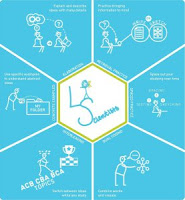6 Evidence based learning strategies
In a previous post I mentioned 3 Dimensions of studying effectively. One of those three dimensions is using effective learning strategies. All over the internet lists of effective studying can be found and I, too, have written several times about this topic (for example, see the above-mentioned post). Now, I have come across an interesting post by Megan Smith en Yana Weinstein in which they describe 6 evidence based strategies for learning some of which are relatively unknown both among teachers and students. Here are those 6 learning strategies:
- Spacing: Spread out your studying over time. Start planning and studying early and spend some time studying each day. It is more effective to spread out your studying like this than to concentrate your studying in one or two days. Each time your start studying spend some time reviewing what your studied before.
- Retrieval Practice: Practice by bringing back to mind what your learned before. For example, try to write down what you have learned before in as much details as you can and then check how you did and what you may have missed or remembered incorrectly. Also, use practice tests and develop your own tools to test your knowledge.
- Elaboration: Explain and describe ideas which you have to learn in detail. Ask yourself qeustion as you are studying about how things precisely work and how concepts are related to each other. Also, try to connect these concepts to your own experiences.
- Interleaving: Do not stick too long with one topic but frequently switch between topich. Study topics in different orders which helps to strengthen your understanding of them.
- Concrete examples: Use concrete examples to understand abstract ideas better. Actively search for examples in your books and on the internet and make your examples. Reflect on how the examples are related to the abstract ideas.
- Dual Coding: Encode the ideas both verbally and visually. Search for visualizations of the things you have to learn and explain them in your own words. Also, make your own visualizations.

Comments